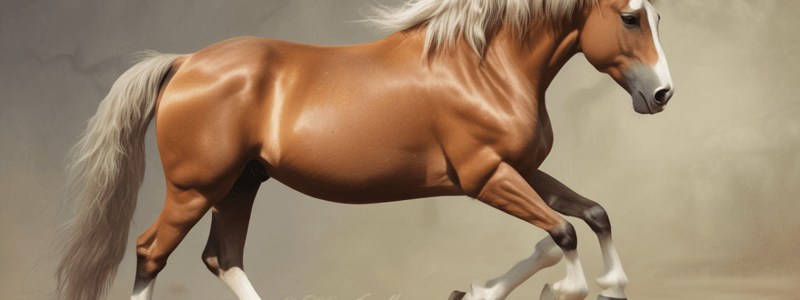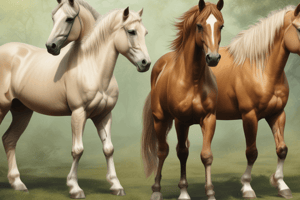Podcast
Questions and Answers
What is the characteristic of a Bay horse?
What is the characteristic of a Bay horse?
- Dark brown with a white mane and tail
- Light brown with a mane and tail of a different color
- Any shade of brown with a black mane and tail (correct)
- Grey with a black mane and tail
What is the normal temperature of a horse?
What is the normal temperature of a horse?
- 98.5-100.5 °F
- 100.5-102.5 °F
- 99.5-101.5 °F (correct)
- 101.5-103.5 °F
What is the ideal body condition score for broodmares?
What is the ideal body condition score for broodmares?
- 6-8
- 4-5
- 5-6
- 5-7 (correct)
What is the characteristic of a Roan horse?
What is the characteristic of a Roan horse?
What is a characteristic of a healthy horse?
What is a characteristic of a healthy horse?
What is the location of the ribs in a horse?
What is the location of the ribs in a horse?
Which of the following nutrients does not include water?
Which of the following nutrients does not include water?
What is a sign of a sick horse?
What is a sign of a sick horse?
What is the primary function of the cecum in a horse's digestive system?
What is the primary function of the cecum in a horse's digestive system?
What is essential for selecting and judging horses?
What is essential for selecting and judging horses?
Fats are one of the six basic nutrients included in all feeds.
Fats are one of the six basic nutrients included in all feeds.
A horse's digestive system is similar to that of a carnivore.
A horse's digestive system is similar to that of a carnivore.
Unsteady gait is a sign of a healthy horse.
Unsteady gait is a sign of a healthy horse.
The cecum is involved in the mechanical digestion of food in the horse.
The cecum is involved in the mechanical digestion of food in the horse.
Breeds are not important when selecting and judging horses.
Breeds are not important when selecting and judging horses.
Flashcards are hidden until you start studying
Study Notes
Breed Definition and Color
- A breed is a group of animals of the same species that share common traits.
- Bay: any shade of brown with a black mane and tail, and often black on the legs.
- Chestnut: generally a darker brown with a mane and tail of the same color.
- Sorrel: a lighter brown with a mane and tail of the same color.
- Grey: usually has dark skin, with a coat that can be any shade of grey with dapples or flea-bitten.
- Black: black coat and skin must be black.
- White: very rare, with a white coat and skin, and often referred to as an albino if it has pink eyes.
- Palomino: coat is the color of a new-minted penny, with a white mane and tail.
- Buckskin: yellow color coat with black mane, tail, and legs.
- Dun: can be various shades of yellow, always with a dorsal stripe.
- Roan: can be strawberry (red and white) or blue (black and white).
Health
- Normal temperature: 99.5-101.5 °F.
- Normal heart rate: 32-48 beats per minute.
- Normal respiratory rate: 8-20 breaths per minute.
- Body condition/weight: should be monitored for fatness or thinness.
- Hair coat: should be shiny and glossy.
- Hoof growth: should be normal, smooth, and uncracked.
- Eyes: should be bright, fully open, clear, and without discharge.
- Normal hydration: should be monitored.
- Normal feces and urine: firm fecal balls, wheat-colored clear urine.
- Healthy pink mucous membranes: should be present in gums and lips.
Body Condition Score
- Most horses should be in a body score of 5-6.
- Broodmares should be a 5-7, and not allowed to lose condition during breeding season.
- Horses over a condition score of 7 may be at a greater risk for developing metabolic disorders.
Nutrition
- All feeds include six basic nutrients: protein, carbohydrates, lipids, minerals, vitamins, and water.
- Protein: an essential nutrient.
- Carbohydrates: an essential nutrient.
- Fats: an essential nutrient.
- Minerals: an essential nutrient.
- Vitamins: an essential nutrient.
- Water: an essential nutrient.
Signs of a Sick Horse
- Bowel changes: a sign of illness.
- Cranky with other horses: a sign of illness.
- Unsteady gait: a sign of illness.
- Depression: a sign of illness.
- Head shaking/tossing: a sign of illness.
- Restless: a sign of illness.
- Rapid breathing: a sign of illness.
- Unexplained sweating: a sign of illness.
- Excitability: a sign of illness.
Digestive System
- The digestive system consists of a single compartment stomach.
- Food is swallowed directly into the stomach, where it is mixed with digestive juices.
- The cecum is a blind pouch or cul-de-sac at the first portion of the large intestine.
- The cecum acts like a rumen and is involved with microbial digestion (fermentation).
Selecting and Judging Horses
- Requires knowledge and information about breeds, conformation/structure, soundness, and movement.
- Breeds: need to be identified and understood.
- Conformation/structure: need to be evaluated.
- Soundness: need to be evaluated.
- Movement: need to be evaluated.
Breed Definition and Color
- A breed is a group of animals of the same species that share common traits.
- Bay: any shade of brown with a black mane and tail, and often black on the legs.
- Chestnut: generally a darker brown with a mane and tail of the same color.
- Sorrel: a lighter brown with a mane and tail of the same color.
- Grey: usually has dark skin, with a coat that can be any shade of grey with dapples or flea-bitten.
- Black: black coat and skin must be black.
- White: very rare, with a white coat and skin, and often referred to as an albino if it has pink eyes.
- Palomino: coat is the color of a new-minted penny, with a white mane and tail.
- Buckskin: yellow color coat with black mane, tail, and legs.
- Dun: can be various shades of yellow, always with a dorsal stripe.
- Roan: can be strawberry (red and white) or blue (black and white).
Health
- Normal temperature: 99.5-101.5 °F.
- Normal heart rate: 32-48 beats per minute.
- Normal respiratory rate: 8-20 breaths per minute.
- Body condition/weight: should be monitored for fatness or thinness.
- Hair coat: should be shiny and glossy.
- Hoof growth: should be normal, smooth, and uncracked.
- Eyes: should be bright, fully open, clear, and without discharge.
- Normal hydration: should be monitored.
- Normal feces and urine: firm fecal balls, wheat-colored clear urine.
- Healthy pink mucous membranes: should be present in gums and lips.
Body Condition Score
- Most horses should be in a body score of 5-6.
- Broodmares should be a 5-7, and not allowed to lose condition during breeding season.
- Horses over a condition score of 7 may be at a greater risk for developing metabolic disorders.
Nutrition
- All feeds include six basic nutrients: protein, carbohydrates, lipids, minerals, vitamins, and water.
- Protein: an essential nutrient.
- Carbohydrates: an essential nutrient.
- Fats: an essential nutrient.
- Minerals: an essential nutrient.
- Vitamins: an essential nutrient.
- Water: an essential nutrient.
Signs of a Sick Horse
- Bowel changes: a sign of illness.
- Cranky with other horses: a sign of illness.
- Unsteady gait: a sign of illness.
- Depression: a sign of illness.
- Head shaking/tossing: a sign of illness.
- Restless: a sign of illness.
- Rapid breathing: a sign of illness.
- Unexplained sweating: a sign of illness.
- Excitability: a sign of illness.
Digestive System
- The digestive system consists of a single compartment stomach.
- Food is swallowed directly into the stomach, where it is mixed with digestive juices.
- The cecum is a blind pouch or cul-de-sac at the first portion of the large intestine.
- The cecum acts like a rumen and is involved with microbial digestion (fermentation).
Selecting and Judging Horses
- Requires knowledge and information about breeds, conformation/structure, soundness, and movement.
- Breeds: need to be identified and understood.
- Conformation/structure: need to be evaluated.
- Soundness: need to be evaluated.
- Movement: need to be evaluated.
Studying That Suits You
Use AI to generate personalized quizzes and flashcards to suit your learning preferences.




